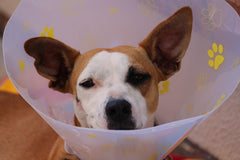
All dog owners should be mindful of what and how they feed their dogs, but with Pitbulls, owners need to be particularly careful about feeding their canine buddies. Improper diet can lead to some avoidable health issues in your pitbull’s future. This is why it’s important to understand what and how you should be feeding your pitbull during all stages of their life.
The Right Way to Feed Your Pitbull

Dogs like Pitbulls may come off at times, as though they would be happy to eat any food that you put down in front of them. This is because they don’t know what foods are best for them. In their minds, you’re the one who knows what is best for them so they trust you to give them what they need when they need it.
Pitbull owners need to understand what nutrients and other components in dog food are essential for your pup. Knowing how often they should eat and how much they should be eating at each meal are both vital.
Make Sure They’re Getting Important Nutrients

Protein is hands down the most important nutrient that you need to make sure is in your pitbull’s diet. Young, growing Pitbulls need to have meals that contain at least 22% protein content. As they grow older, you can decrease their protein intake to about 18% protein. You’ll want to feed your Pitbulls high-quality dog food to ensure that they are getting their necessary protein intake each day.
Fat content is also an important nutrient to keep tabs on in your pitbulls diet. For pitbull puppies, about 8% fat is recommended to help their little bodies grow as well as to fuel their daily puppy activities. Adult Pitbulls, on the other hand, need less fat content in their food to avoid excessive weight gain that could potentially damage their joints over time. A good dog food for Pitbulls will contain a good balance of all of these important nutrients.
Stick to a Regular Feeding Schedule

Pitbulls love food, and would eat all day if you let them. To avoid them gaining weight, creating a feeding schedule where they eat just a serving size of their food is important. A fat Pitbull might sound adorable, but they will suffer from health complications if they become overweight from eating too much, too often.
You have control over when they eat, and how much they are eating for one. Rather than leaving an auto feeder out that will dispense dry food for them continuously all day, you are giving them controlled portions at the same time every day. This helps your pitbull to maintain a healthy weight and learn to eat only when it’s mealtime.
Everyone involved will benefit from setting a meal schedule for your Pitbulls. They won’t be waking you up at odd hours telling you that it’s time to eat or become hungry midday while you are away at work or running errands. Their internal meal clocks will know mealtimes are and only remind you that it's time to eat at those designated times. Just be sure to pick times of day that work with your schedule so that you can be sure to keep their routine consistent.
Be Mindful of the Quantity of Each Meal

Typically, the ideal serving size for Pitbull's meals is 1.5-2.5 cups of their food twice a day and this goes for wet or dry food. Depending on where your pitbull is with their weight, you can feed them at the higher or lower end of the recommended serving size range.
Knowing that 1.5-2.5 cups of food is the ideal serving size for your pitbull, it’s important to keep in mind that snacking throughout the day should be fairly limited. This is to avoid getting them into the habit of wanting to eat food all day long, instead of abiding by their meal schedule and feeling satisfied with the right portions they are meant to eat. That, and to prevent excessive weight gain that can come with allowing you pitbull to overindulge in dog treats between meals.
What Should I Know about Feeding my Pitbull Puppy?
The most important thing to understand about feeding a pitbull puppy versus a grown pitbull is that the puppy is still growing and will need a diet that is very different from adult Pitbulls.
They Need Lots of Good Nutrients to Help them Grow

Their nutrient intake will be proportionally higher than what adult Pitbulls are recommended to take in daily. They need a higher fat and protein content in their food to support their growing bodies and seemingly limitless stores of energy.
The best puppy food for Pitbulls should contain at least 22% protein content and at least 8% fat. Pitbulls as a breed are very energetic at all stages in life, but puppies are especially rambunctious and full of energy. They need these extra nutrients to help them grow big and strong.
Conclusion
Pitbulls are naturally energetic and muscular breeds of dogs, meaning they have a ferocious appetite to help keep them fueled all day long. As their owner is important to regulate this mighty appetite they have, for the good of their health at all stages of their lives. Providing your young or adult pitbull with the right nutrients and meal size on a consistent schedule is incredibly beneficial for the health and well-being of your beloved pitbull.
How much food should I feed my pitbull dog?
What’s the best dog food for Pitbulls to gain weight?
What dry dog food is best for Pitbulls?
Check out our blog and follow me on LinkedIn to stay up-to-date!




